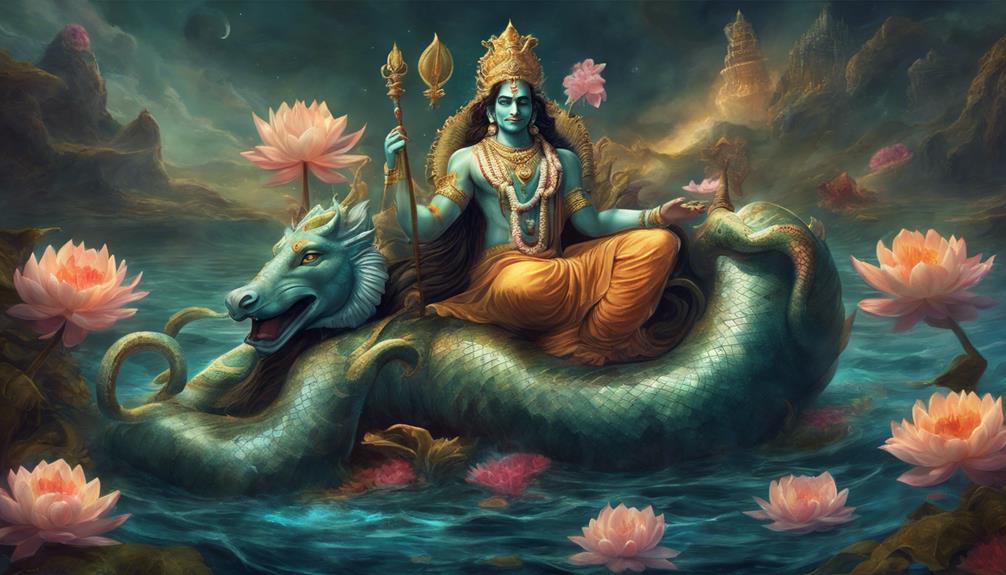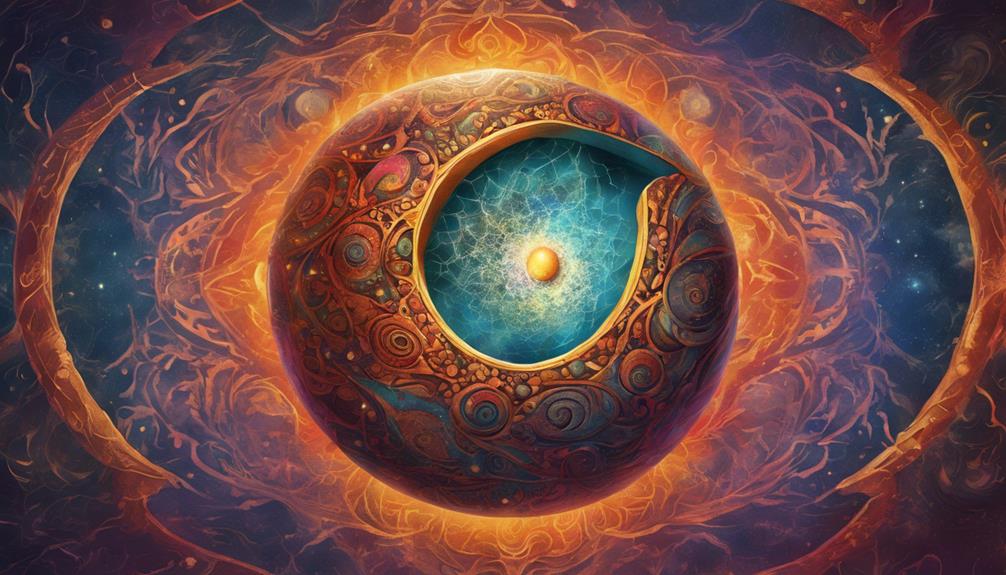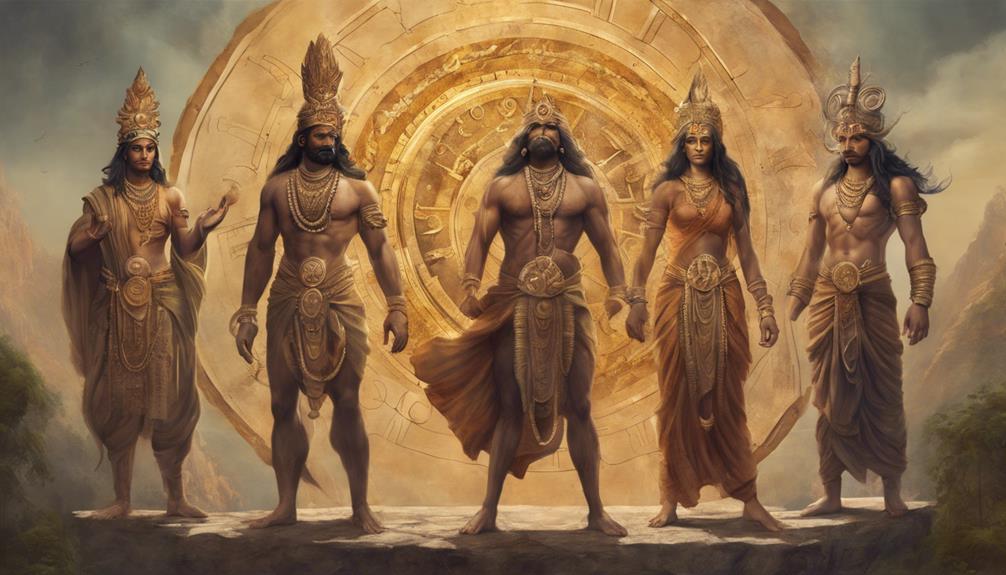In Hindu mythology, the creation of the universe is explained through the intricate interplay of divine births, cyclical creations, and eternal balance between the forces of creation and destruction. Brahma, the creator deity, initiates cosmic birth, while Vishnu maintains universal harmony and Shiva guarantees renewal through destruction. The symbolism of the Cosmic Egg, the eternal struggle between Devas and Asuras, and the Four Yugas Cycle all reflect the deep cosmological narrative of Hindu beliefs. This rich tapestry of stories and symbols reveals a profound understanding of existence and the continuous cycle of creation and rebirth.
Table of Contents
Key Takeaways
- Hindu mythology depicts creation through eternal cycles of birth and destruction.
- Deities like Brahma, Vishnu, and Shiva play crucial roles in cosmic creation, preservation, and renewal.
- Symbolism in myths like the Cosmic Egg and divine dances conveys the essence of creation.
- The eternal battle between Devas and Asuras symbolizes the cosmic balance of good and evil.
- The Four Yugas illustrate the cyclical nature of time and spiritual evolution in the universe.
The Birth of the Universe
In Hindu mythology, the birth of the universe is intricately tied to the concept of creation and the cosmic cycles of existence. The cosmic origins in Hinduism are rooted in the belief that the universe goes through infinite cycles of creation and destruction. This eternal process of universal birth and rebirth is known as the concept of 'Srishti' and 'Pralaya'. According to Hindu cosmology, the universe isn't a singular creation but rather a manifestation of divine energy that constantly evolves and dissolves in a never-ending cycle.
The concept of universal birth in Hindu mythology is often symbolized by the deity Brahma, who's believed to be the creator of the universe. Brahma is depicted as having four heads, each facing a different direction, symbolizing his omnipresence and his role in creating and overseeing the cosmic order. Through his divine will, Brahma initiates the process of creation, giving rise to the diverse forms and beings that inhabit the universe. This intricate interplay of cosmic forces and energies highlights the profound interconnectedness of all existence in Hindu cosmology.
Brahmas Creation Story
As you explore Brahma's Creation Story, you'll uncover the intricate details of Brahma's creative process and the origin of the universe. Understanding how Brahma shaped the cosmos and brought it into existence sheds light on the profound mythological constructs that underpin Hindu cosmogony.
Delving into Brahma's Creation Story offers a glimpse into the ancient wisdom that has shaped Hindu beliefs about the origins of the universe.
Brahmas Creative Process
Brahma, the creator deity in Hindu mythology, initiated the process of creation through a profound and intricate cosmic dance. This dance symbolized the beginning of Brahmas creation process, where he brought forth the universe into existence.
As Brahma performed his cosmic dance, he meticulously balanced the forces of creation, preservation, and destruction, ensuring cosmic harmony and order. The intricate movements of his dance wove together the fabric of reality, establishing the foundations of the universe.
Through his creative process, Brahma meticulously orchestrated the birth of galaxies, stars, planets, and life forms, all while maintaining the delicate cosmic balance essential for the sustenance of the universe. This divine dance of creation showcases Brahmas immense power and wisdom in shaping the cosmos.
Origin of Universe
During Brahma's creation story, the universe unfolded through a cosmic dance of intricate movements, weaving together the fabric of reality and establishing the foundations of existence.
In Hindu cosmology, the origin of the universe is rooted in cosmic beginnings and universal origins. Creation myths and ancient beliefs depict Brahma as the ultimate creator, whose divine energy set in motion the cosmic order.
Through his creative prowess, Brahma manifested the universe, bringing forth galaxies, stars, planets, and life forms. The concept of creation in Hindu mythology is a profound reflection of the interconnectedness of all things and the intricate balance that sustains the cosmos.
Understanding Brahma's role in the origin of the universe provides insights into the rich tapestry of Hindu cosmogony and the enduring significance of ancient beliefs.
Vishnus Preservation Role

Vishnu's preservation role in Hindu mythology intricately weaves together the fabric of existence, ensuring the harmony and balance of the universe. As the preserver among the Hindu trinity, Vishnu's intervention is paramount in maintaining cosmic balance and upholding the cosmic order. Vishnu is depicted as resting on the cosmic serpent Shesha, with his four arms symbolizing his omnipresence, omnipotence, creation, and destruction. Through his various avatars like Rama and Krishna, Vishnu restores righteousness and order, protecting the universe from chaos and decay.
The concept of preservation in Hindu mythology highlights Vishnu's unwavering commitment to safeguarding dharma (righteousness) and maintaining equilibrium in the cosmos. Vishnu's role extends beyond mere sustenance; it embodies the constant battle against forces that threaten to disrupt the delicate balance of existence. Through his actions and avatars, Vishnu exemplifies the significance of upholding moral values and preserving the cosmic harmony that underpins the universe. Essentially, Vishnu's preservation role serves as a guiding light, illuminating the path towards spiritual enlightenment and cosmic stability.
Shivas Destruction and Renewal
Shiva's role in Hindu mythology as the guardian of destruction and renewal is a profound manifestation of cosmic transformation and regeneration. Central to this role is Shiva's cosmic dance, known as the Tandava, which symbolizes the rhythmic balance between creation and destruction. In Hindu belief, destruction isn't merely about annihilation but is crucial for the renewal and rejuvenation of the universe. Shiva's dance embodies this concept, where the destruction of the old paves the way for new beginnings.
The destruction aspect of Shiva's role isn't one of chaos but of necessary change. By dismantling the old and making way for the new, Shiva ensures that cosmic equilibrium is maintained. Through destruction, Shiva clears the path for renewal, allowing for growth, transformation, and evolution. This cyclical process of destruction and renewal is essential for the perpetuation of the universe, emphasizing the interconnectedness of all things in Hindu cosmology. Shiva's dance, hence, symbolizes the eternal rhythm of creation, preservation, and destruction, ultimately upholding the cosmic order.
The Cosmic Egg Theory

The concept of the Cosmic Egg Theory in Hindu mythology offers a profound insight into the origins and structure of the universe. In Hindu creation mythologies, the Cosmic Egg, known as Hiranyagarbha, symbolizes the primal state of the universe before its manifestation. The egg represents the cosmic womb from which all existence emerged. Within this cosmic egg, the potentiality of creation lay dormant, waiting to unfold.
The Cosmic Egg symbolism holds significant meaning in Hindu cosmology. It illustrates the idea of the universe originating from a singular source, encapsulating the vastness and complexity of existence in a single entity. The cracking of the egg symbolizes the moment of creation, where the universe expands and evolves from its core. This imagery mirrors the cyclical nature of existence, where creation, preservation, and destruction are intertwined in a continuous process.
The Churning of the Ocean
As you explore the mythological tale of the Churning of the Ocean in Hindu cosmology, you'll uncover profound insights into the eternal struggle between the Devas (celestial beings) and the Asuras (demons).
This cosmic event symbolizes the eternal battle between good and evil, light and darkness, highlighting the universal themes of duality and balance.
Through this churning, significant treasures like the divine nectar of immortality and the wish-fulfilling tree emerged, enriching the fabric of Hindu mythology with layers of meaning and significance.
Ocean Churning Significance
During the cosmic event known as the Ocean Churning, deities and demons engaged in a monumental task to obtain the nectar of immortality. This mythological symbolism represents the pivotal struggle between good and evil, light and darkness, creating a cosmic balance essential in Hindu mythology.
The churning process signifies the constant cycle of creation, preservation, and destruction that sustains the universe. The Devas and Asuras working together on this task highlight the importance of harmony and cooperation in achieving divine goals.
Through this intricate tale, Hindu mythology imparts the idea that balance and equilibrium are essential for the cosmic order to prevail, emphasizing the cyclical nature of existence and the eternal quest for immortality and enlightenment.
Devas Vs. Asuras
Amidst the cosmic turmoil of the Ocean Churning, the Devas and Asuras clashed in a fierce battle for supremacy and the coveted nectar of immortality. This divine conflict between the two powerful entities symbolizes a perpetual power struggle within Hindu mythology.
The Devas, representing the forces of good, and the Asuras, embodying the forces of evil, engaged in this epic struggle to explore the cosmic balance in their favor. This eternal rivalry between the Devas and Asuras reflects the ongoing battle between light and darkness, righteousness and malevolence.
Through this grand narrative of the Ocean Churning, Hindu mythology examines the complexities of morality and the intricate interplay of opposing forces shaping the universe.
Emergence of Treasures
In the cosmic saga of the Ocean Churning, a plethora of divine treasures emerged, each holding profound significance in shaping the fabric of the universe.
Hidden treasures surfaced from the depths, symbolizing the emergence of profound wisdom and enlightenment. These mythical treasures, such as the celestial cow Kamadhenu and the wish-fulfilling tree Kalpavriksha, weren't mere material riches but embodiments of cosmic balance and divine energy.
The churning process brought forth symbolic meanings, representing the essential struggle between good and evil, light and darkness. Each treasure that emerged played a crucial role in maintaining equilibrium in the universe, highlighting the intricate interconnectedness of all beings and the underlying cosmic order that governs existence.
The Role of Devas and Asuras
The dynamic interplay between Devas and Asuras in Hindu mythology exemplifies the eternal struggle between forces of righteousness and discord. Devas, often considered benevolent celestial beings embodying light and goodness, stand in contrast to the Asuras, who are depicted as power-seeking entities representing darkness and chaos. This dichotomy sets the stage for the recurring mythological battles between the two groups, symbolizing the perpetual cosmic conflict between virtue and vice.
Devas are associated with traits such as selflessness, wisdom, and compassion, aligning them with divine qualities that uphold cosmic order. In contrast, Asuras are driven by ego, envy, and aggression, leading them to challenge the authority of the Devas and disrupt harmony in the universe. These opposing dynamics between Devas and Asuras serve as a metaphor for the eternal struggle between good and evil, emphasizing the importance of upholding righteousness and virtue in the face of adversity. The mythological battles between Devas and Asuras reflect the timeless theme of cosmic balance and moral resilience in Hindu mythology.
The Four Yugas Cycle

Within Hindu mythology, the Four Yugas Cycle represents a fundamental concept outlining the cyclical nature of time and the evolution of human civilization. The Yugas, or ages, are time periods that symbolize different stages of spiritual evolution. The four Yugas are Satya Yuga, Treta Yuga, Dvapara Yuga, and Kali Yuga. These Yugas follow a specific order, representing a decline in moral and ethical standards as time progresses.
Yuga transformations mark the shift from one age to another, signaling the cosmic cycles that govern the universe's rhythm. Satya Yuga, also known as the Golden Age, is characterized by virtue, righteousness, and truth. As time moves forward, the subsequent Yugas witness a gradual decline in these values. Kali Yuga, the current age, is believed to be the most tumultuous period, marked by moral degradation and spiritual darkness.
Understanding the Four Yugas Cycle provides insight into the cyclical nature of time and the importance of spiritual growth throughout different epochs in Hindu cosmology.
The Symbolism of Creation
Symbolically representing the genesis of existence, Hindu mythology intricately weaves together narratives that elucidate the profound mysteries surrounding the creation of the universe. Within these intricate tales, the symbolism of creation often revolves around the concept of cosmic balance. This balance is depicted through the interplay of various deities and forces, each representing different aspects of existence.
For instance, the story of Brahma, Vishnu, and Shiva exemplifies the cyclical nature of creation, preservation, and destruction in the universe. Brahma symbolizes the creator, Vishnu the preserver, and Shiva the destroyer, showcasing the continuous cycle of birth, life, and death.
Moreover, the symbolism of creation in Hindu mythology also underscores the interconnectedness of all beings and elements in the universe. Each entity, whether divine or mortal, plays an essential role in maintaining the cosmic balance and harmony.
Frequently Asked Questions
How Do the Stories of Brahma, Vishnu, and Shiva Interact With Each Other in the Creation, Preservation, and Destruction of the Universe?
In Hindu mythology, the dynamics between Brahma, Vishnu, and Shiva are central to creation myths. Brahma creates, Vishnu preserves, and Shiva destroys to bring about the cycle of creation, preservation, and destruction in the universe.
What Significance Do the Deities, Deva and Asuras, Play in the Creation and Maintenance of the Universe According to Hindu Mythology?
In Hindu mythology, the deities, devas, and asuras are essential players in maintaining cosmic balance. Their roles are pivotal in upholding order and harmony in the universe, with devas representing the forces of good and asuras embodying the forces of chaos.
How Do the Four Yugas Cycle Represent the Different Stages of Creation and Existence in Hindu Mythology?
In Hindu mythology, the four Yugas cycle symbolizes the cosmic order and different creation stages. They embody eternal truths and represent the various phases of existence. Understanding these cycles deepens your insight into the universe's intricate design.
What Is the Symbolic Significance Behind the Cosmic Egg Theory in Hindu Mythology and How Does It Relate to the Creation of the Universe?
In Hindu mythology, the cosmic egg theory serves as a symbolic representation of creation, encapsulating the potential for the universe's birth. This creation theory highlights the essence of existence and the interconnectedness of all beings in Hindu mythology.
How Does the Churning of the Ocean Story Explain the Concept of Renewal and Transformation in Hindu Mythology?
In Hindu mythology, the churning of the ocean story serves as a vivid renewal symbolism, depicting the eternal cycle of creation and destruction. It is a powerful transformation allegory, showcasing how challenges lead to growth.
Conclusion
To sum up, Hindu mythology offers a rich and intricate explanation for the creation of the universe. Through the stories of Brahma, Vishnu, and Shiva, along with the cosmic egg theory, the churning of the ocean, and the symbolism of creation, Hindus have crafted a complex and profound understanding of how the universe came to be.
The role of Devas and Asuras, the four yugas cycle, and the constant cycle of destruction and renewal all contribute to a deep and meaningful exploration of the origins of existence.